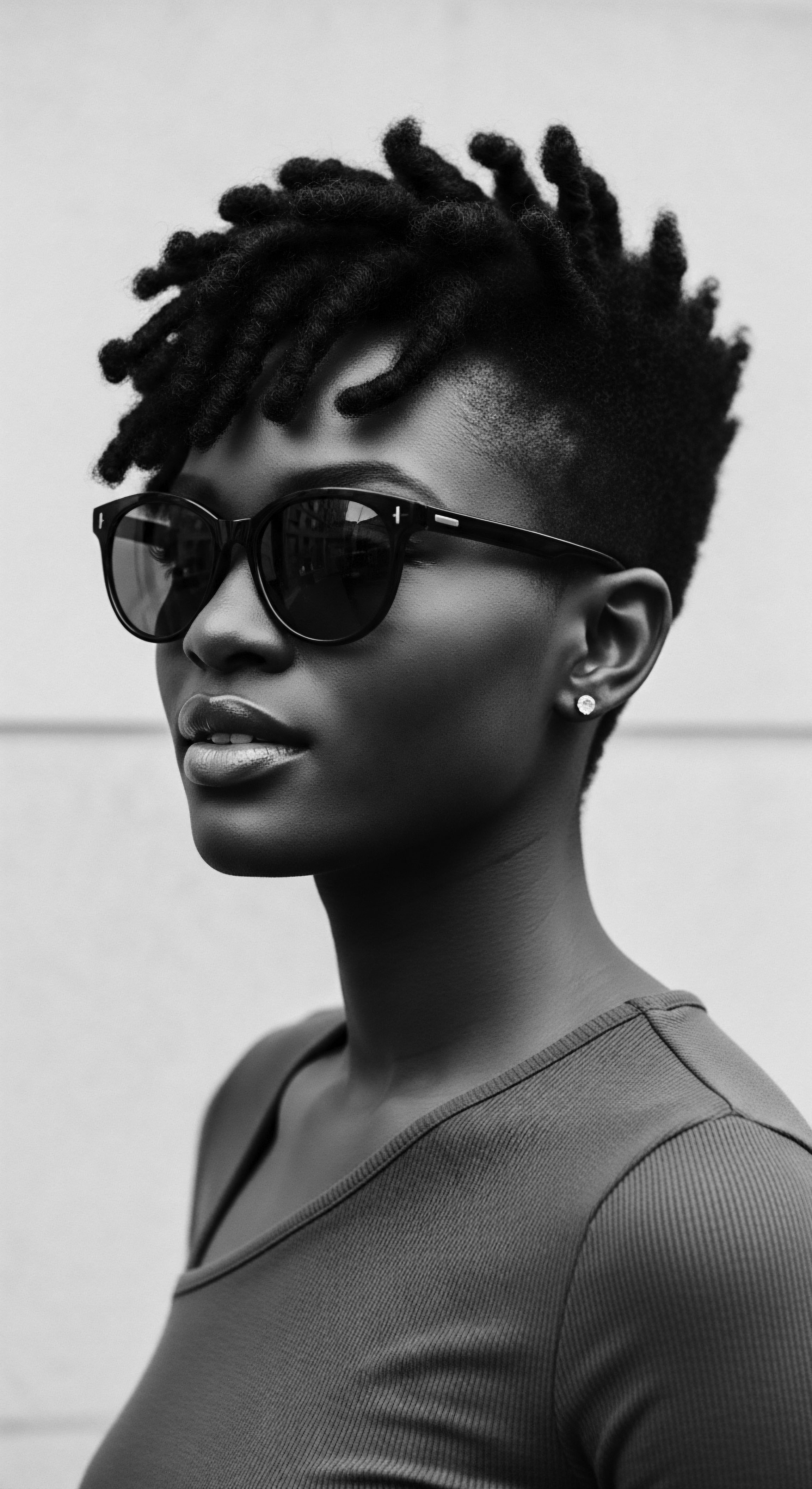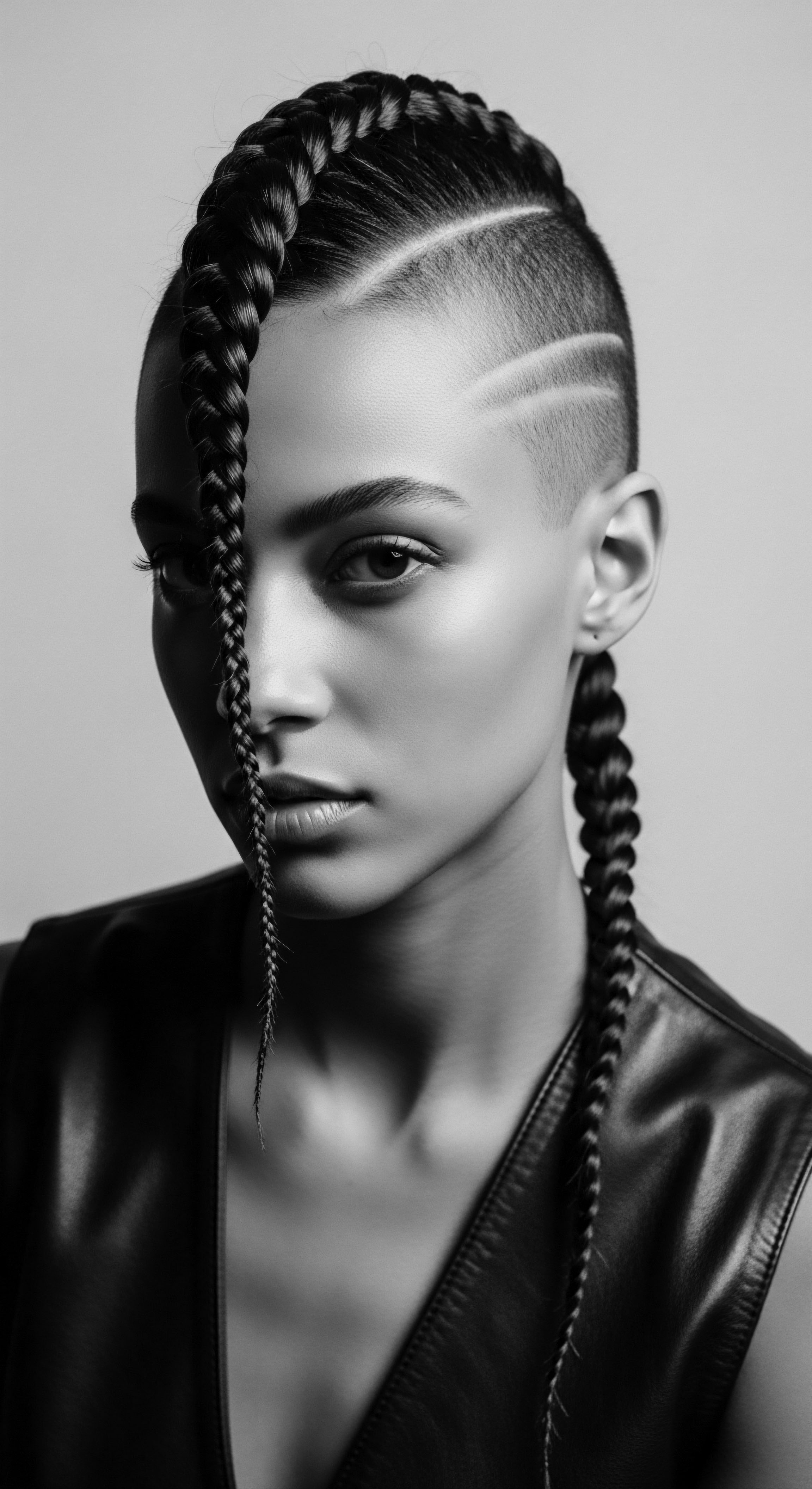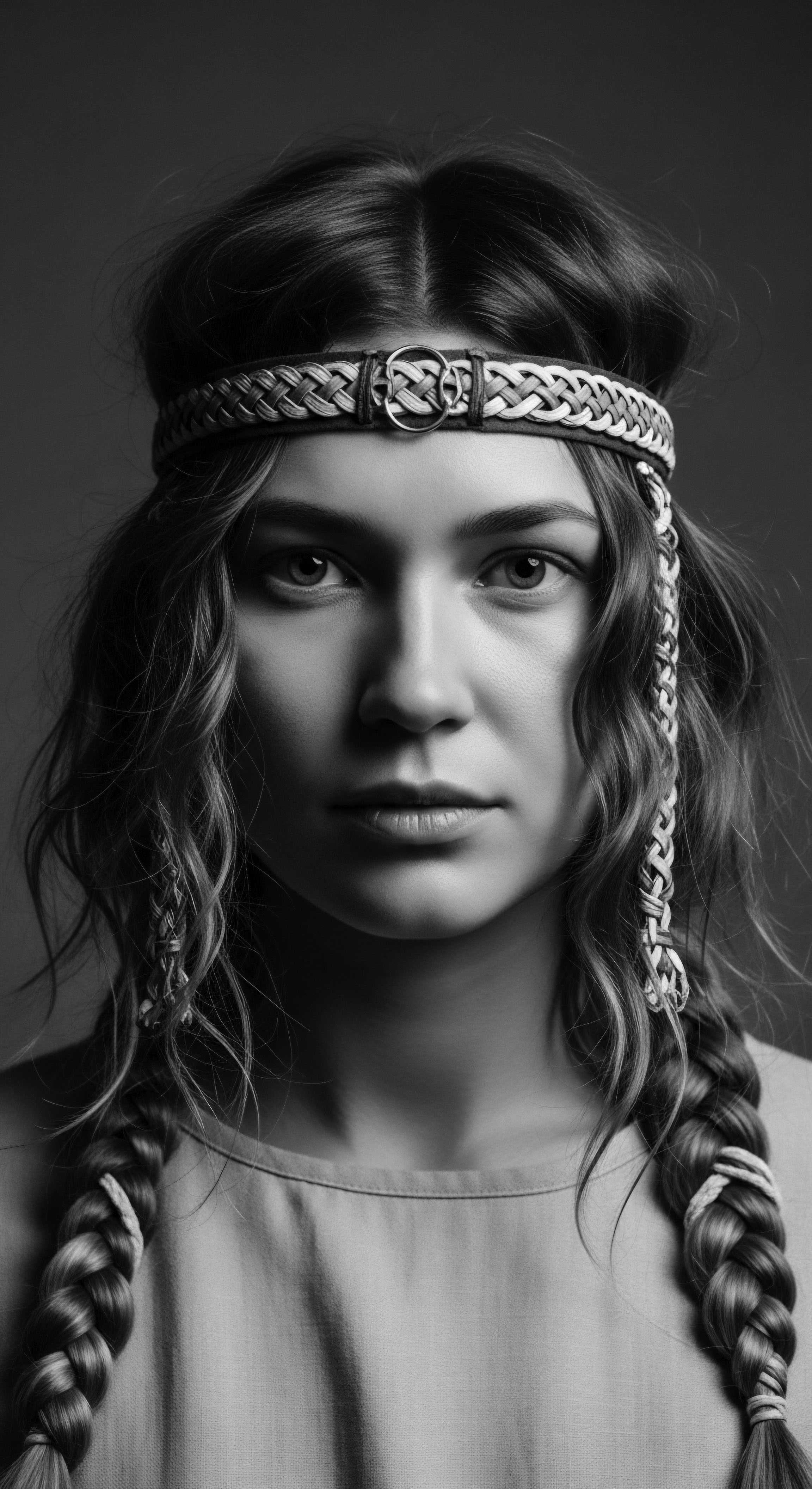
Roots
When we speak of hair, particularly the magnificent, varied textures that grace so many of us, we often speak of more than mere keratin and pigment. We speak of memory, of resilience, of a deep, abiding connection to the very origins of who we are. For those whose lineage traces back through the rich soils of Africa, across oceans, and into the diverse diasporas, our coils, kinks, and waves carry echoes of history.
They are living archives, whispering stories of survival, artistry, and a heritage that refuses to be silenced. Within this continuum, the thoughtful care we give our hair, particularly through styles designed for its safeguarding, represents a profound act of honoring that continuum.
Consider the delicate architecture of a single strand of textured hair. Unlike its straighter counterparts, it twists and turns, its elliptical shape contributing to a unique structural integrity, yet also presenting specific considerations for its well-being. The cuticle layers, those overlapping scales that form the outermost protective sheath, may be more prone to lifting at the curves and bends of each coil.
This particular geometry means that natural oils produced by the scalp, meant to lubricate and protect the length of the strand, travel with more difficulty down a spiraled path. The result can be hair that, while robust in its natural state, also requires specific approaches to retain moisture and resist the environmental stresses of daily living.

The Sacred Geometry of Hair
Understanding the physical makeup of textured hair, from the medulla’s inner core to the cuticle’s exterior, helps us appreciate why certain care practices have endured for generations. The very shape of the hair follicle, which dictates the curvature of the strand, defines its inherent characteristics. A more elliptical follicle yields a tighter curl or coil, while a more circular one produces straighter hair. This biological truth underscores how the unique demands of textured hair—its tendency towards dryness, its propensity for tangling, and its susceptibility to breakage at points of greatest curvature—have long informed ancestral care practices.
The distinctive structure of textured hair calls for specific, heritage-informed care to maintain its inherent strength and beauty.
Centuries before microscopes revealed cellular structures, communities observed these properties. They understood that hair thrived when shielded from harsh elements and excessive manipulation. This observation, passed down through oral traditions and lived experience, became the bedrock of care. The practices that arose were not merely cosmetic; they were a direct response to the hair’s natural inclinations, a quiet agreement between person and strand.

Ancestral Wisdom in Hair Safeguarding
Long before the terms ‘protective style’ became part of contemporary beauty language, indigenous communities across Africa developed sophisticated methods for styling and protecting hair. These were not simply decorative gestures. They were pragmatic solutions, born of necessity and deep environmental awareness, ensuring the hair remained healthy in varying climates, from arid deserts to humid rainforests.
Such methods also communicated social status, tribal affiliation, marital standing, and spiritual beliefs. The intertwining of practicality and profound cultural significance shaped these early forms of safeguarding.
- Adornment ❉ The addition of cowrie shells, beads, or precious metals not only embellished styles but often provided additional weight or structure, helping to keep hair secured and minimized exposure.
- Oiling ❉ Regular application of natural oils like shea butter, palm oil, or castor oil, often infused with herbs, formed a barrier against dryness and environmental aggressors. This practice also helped seal the cuticle, smoothing down the very scales that modern science identifies as prone to lifting on coiled strands.
- Wrapping ❉ Headwraps and elaborate coverings, fashioned from textiles, provided a physical shield from sun, dust, and wind, preventing damage and retaining moisture for extended periods.
These historical precedents demonstrate a foundational understanding of hair well-being that resonates even today. The intent was always to preserve the hair’s integrity, extend its longevity, and maintain its vitality. These careful methods laid the groundwork for what we now recognize as protective styling—an unbroken chain of wisdom connecting us to ancient forms of hair veneration and care.

Ritual
The acts of washing, detangling, braiding, and adorning textured hair have never been merely chores for many Black and mixed-race people; they are rituals. They represent moments of connection—to oneself, to family, and to the enduring spirit of one’s heritage. Within these rituals, protective styles stand as central tenets, physical manifestations of inherited knowledge and communal well-being. These practices, passed from elder to youth, from mother to daughter, from community member to neighbor, weave a tender thread through generations, affirming identity and continuity.
The very word ‘ritual’ implies a repetition, a set of actions imbued with meaning beyond their immediate function. In the context of textured hair, these rituals are often performed with a mindful, almost reverent touch, reflecting an ancestral understanding that hair is a living part of us, deserving of gentle attention. The communal nature of hair braiding, particularly, stands as a testament to this.
Gatherings where hands worked in unison, creating intricate patterns, reinforced familial bonds and transmitted cultural narratives. These were spaces of learning, of sharing, of quiet resilience.

The Gentle Hand of Ancestry
Consider the meticulous process of braiding or twisting. Each segment of hair is carefully separated, detangled, and then coiled or interwoven with intention. This systematic approach reduces daily manipulation, limits exposure to environmental stressors, and minimizes friction against clothing or bedding.
When hair is secured in braids, twists, or cornrows, the delicate cuticle layers remain less disturbed, preventing moisture loss and diminishing the potential for mechanical damage. This thoughtful structuring allows the hair to rest and recuperate.
Historical accounts and contemporary ethnographies consistently highlight the communal aspect of hair care in various African societies and their diasporic descendants. For instance, in many West African cultures, the act of braiding hair was a social activity, often performed outdoors in communal spaces. Children would observe and learn, absorbing not only the techniques but also the stories, songs, and wisdom shared during these sessions.
This intergenerational transfer of skill and knowledge underscores how protective styling transcends mere aesthetics. It becomes a vehicle for cultural preservation and communal bonding.
| Ancestral Practice Utilizing plant-based emollients like unrefined shea butter or palm kernel oil. |
| Underlying Principle Sealing moisture, providing lubrication, promoting flexibility. |
| Contemporary Protective Style Parallel Using leave-in conditioners and natural oils to prep hair for braids or twists. |
| Ancestral Practice Styling hair into elaborate, secured patterns for days or weeks. |
| Underlying Principle Minimizing daily manipulation, shielding from elements, maintaining structured integrity. |
| Contemporary Protective Style Parallel Box braids, knotless braids, twists, cornrows, locs—all reduce daily friction. |
| Ancestral Practice Employing specific combs carved from wood or bone. |
| Underlying Principle Gentle detangling, distributing oils evenly, minimizing breakage. |
| Contemporary Protective Style Parallel Wide-tooth combs and fingers for detangling before and during styling. |
| Ancestral Practice These parallels reveal a timeless wisdom in how protective styling supports hair well-being and longevity. |
The materials used in protective styles, whether the natural fibers woven into extensions or the beads adorning braids, also hold significance. Often, these were materials readily available from the local environment, deepening the connection between the style, the land, and the community’s resourcefulness. This mindful selection, rooted in an intimate understanding of local flora and fauna, contributes to the holistic nature of these practices.

Does Hair’s Protective State Affect Scalp Health?
Indeed, the state of hair protection directly influences the scalp, which forms the foundation for hair growth. A well-executed protective style minimizes tension on the hair follicles, thereby reducing the risk of traction alopecia, a form of hair loss caused by repeated pulling on the hair. When tension is distributed evenly, and the scalp is allowed to breathe, blood circulation remains unimpeded, delivering vital nutrients to the hair bulb. Conversely, styles that are too tight or worn for excessive durations can stress the scalp, impeding healthy growth patterns.
The historical longevity of styles such as threaded hair, where natural fibers are used to wrap and stretch hair, suggests an empirical understanding of gentle tension. These styles, often seen in various African regions, created elongated, elegant forms while safeguarding the natural hair, allowing it to rest and grow unhindered by daily manipulation. The scalp, within these traditional frameworks, was not an afterthought; it was tended with care, often massaged with herbal infusions to promote vitality.
Protective styles, when thoughtfully applied, shield hair from environmental strain while simultaneously promoting scalp health, a practice deeply ingrained in ancestral knowledge.
This interplay between protecting the hair shaft and supporting the scalp underscores the holistic nature of these traditional practices. They understood that healthy hair grows from a healthy scalp, and true protection encompassed both. The meticulous preparation of the hair and scalp before a protective style, involving cleansing and oiling, mirrored the thoughtful approach to overall well-being.

Relay
The journey of textured hair and its safeguarding practices is a living relay, a continuous transfer of knowledge, identity, and spirit across time and geography. From ancient African kingdoms to contemporary global communities, the significance of protective styles has transcended mere utility; it has become a powerful language of self-expression, cultural reclamation, and ancestral reverence. In moments of great adversity, when external forces sought to diminish or erase Black identity, hair, and the styles it wore, often stood as an unyielding beacon of resistance and continuity.
The transatlantic slave trade ripped people from their homelands, severing direct ties to ancestral practices, yet the wisdom of hair care persisted. Ingenuity became paramount. Without traditional tools or materials, enslaved people adapted, using whatever was at hand—twine, thread, or even found fabrics—to create styles that protected hair while also subtly communicating messages of escape routes, family lineages, or spiritual solidarity. These styles, often simple cornrows or braided patterns, became quiet acts of defiance, preserving a piece of self that could not be taken away.

Hair as a Map of Heritage
In the African diaspora, especially in contexts where hair textures were often denigrated or deemed “unprofessional,” protective styles became acts of profound cultural affirmation. They allowed individuals to maintain the health of their natural hair while navigating societal pressures. For generations, these styles served as silent narratives, connecting individuals to a heritage often denied or distorted. A specific braid pattern might echo designs seen on ancient African sculptures, or a particular style might signify belonging to a specific lineage or community.
A powerful illustration of hair as a repository of historical information comes from the practice of cornrowing among enslaved Africans in Colombia. Ann M. Head, in her 2002 paper for the National Library of Medicine, documents how women in Cartagena would braid rice, seeds, or even gold into their hair, creating intricate cornrow patterns that doubled as maps to freedom or methods of carrying sustenance. These styles, seemingly decorative, were coded messages, vital to survival and resistance.
The very act of styling became an act of liberation, each plait a step towards reclaiming autonomy and preserving ancestral memory. This example dramatically underscores the profound functional and symbolic importance of protective styles beyond mere aesthetics, rooting them deeply in heritage and survival.

Can Protective Styles Alter Hair’s Growth Trajectory?
Protective styles do not alter the inherent genetic programming of hair growth but rather optimize the conditions for that growth to occur unhindered. By minimizing external stressors, reducing manipulation, and maintaining moisture, these styles allow hair to reach its genetic length potential without premature breakage. When hair is constantly exposed to friction, harsh weather, or frequent styling, it may experience breakage before it reaches its full length. Protective styles mitigate this, creating an environment where strands can thrive.
The idea of ‘length retention’ is central here. Textured hair, despite its appearance of strength, can be prone to breakage along its many curves. Protective styles reduce this vulnerability, allowing the hair to retain the length it grows. This physical safeguarding is reinforced by the conscious care taken before and during the installation of such styles, emphasizing gentle detangling and moisturizing, practices that themselves are steeped in generations of learned wisdom.
The continuous evolution of protective styles in contemporary society reflects this ongoing relay. From the revival of traditional cornrows and twists to the innovation of knotless braids and crochet styles, each adaptation builds upon a historical foundation. Modern stylists, drawing from scientific understanding, refine techniques to ensure maximum protection with minimal tension, honoring the ancient principles while adapting them for current needs and aesthetic preferences. This adaptability speaks to the dynamic nature of heritage itself—not static, but ever-renewing, always connected to its source.
As a language of identity and survival, protective styles represent an ongoing cultural relay, optimizing hair health through ancestral wisdom and modern adaptation.
The conscious choice to wear protective styles also functions as a powerful statement in the present day. It signifies a reclaiming of Black beauty standards, a rejection of Eurocentric ideals, and an affirmation of one’s unique heritage. In professional spaces, academic settings, and social environments, these styles assert presence and pride, challenging long-held biases and opening pathways for broader acceptance and celebration of textured hair in all its forms.

Reflection
To consider protective styles is to stand at a confluence of biology, history, and spirit. It is to acknowledge that a single strand of hair holds within it the whispers of ancestors, the resilience of generations, and the promise of a future unburdened by narrow definitions of beauty. The ‘Soul of a Strand’ ethos reminds us that our hair is not merely an accessory; it is a vital part of our physical being and a profound marker of our shared cultural legacy. From the inherent structure of textured coils to the deliberate, loving acts of braiding and twisting, these practices reflect an unbroken chain of wisdom—a legacy of care and affirmation that has endured against all odds.
The enduring significance of protective styles lies in their dual capacity ❉ they physically preserve the health of textured hair, allowing it to flourish, while simultaneously safeguarding a vibrant heritage. They are living testaments to adaptability, creativity, and the unwavering spirit of Black and mixed-race communities. Each braid, each twist, each thoughtful wrap is a continuation of an ancestral conversation, a silent yet potent declaration of identity and belonging. Our hair, protected and honored, becomes a luminous archive, carrying the stories forward, ensuring that the legacy of care, beauty, and resilience continues its unbroken relay for generations yet to come.

References
- Head, Ann M. “Soulful Strands ❉ The Cultural Significance of Black Hair.” Journal of the National Medical Association, vol. 94, no. 12, 2002, pp. 1045–1052.
- Byrd, Ayana D. and Lori L. Tharps. Hair Story ❉ Untangling the Roots of Black Hair in America. St. Martin’s Press, 2001.
- Mercer, Kobena. Welcome to the Jungle ❉ New Positions in Black Cultural Studies. Routledge, 1994.
- Banks, Ingrid. Hair Matters ❉ Beauty, Power, and the Politics of African American Women’s Hair. New York University Press, 2000.
- Patton, Tracey Owusu. African-American Hair as Culture and Commerce. Palgrave Macmillan, 2006.
- Gordon, Joanne. The Importance of Hair in African and African American Culture. African American Hair & Skin Care, 2006.
- Cobb, L. R. “Braiding and Hair Care in African and African American Cultures.” Journal of Black Studies, vol. 37, no. 5, 2007, pp. 687–704.
